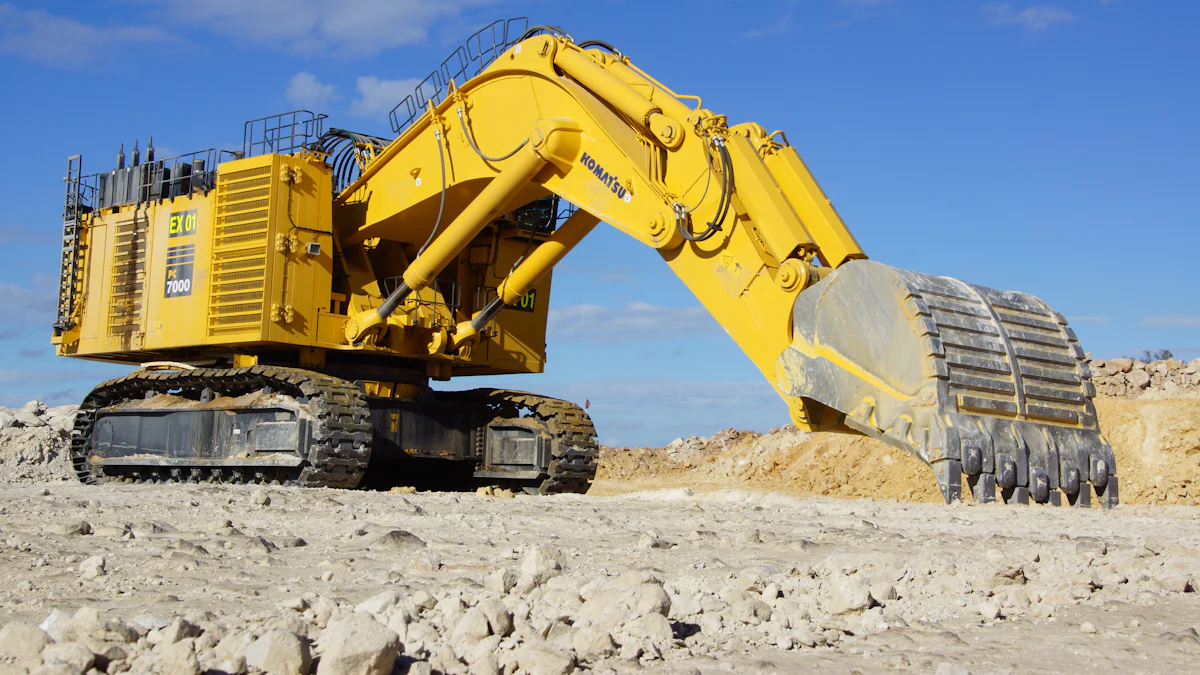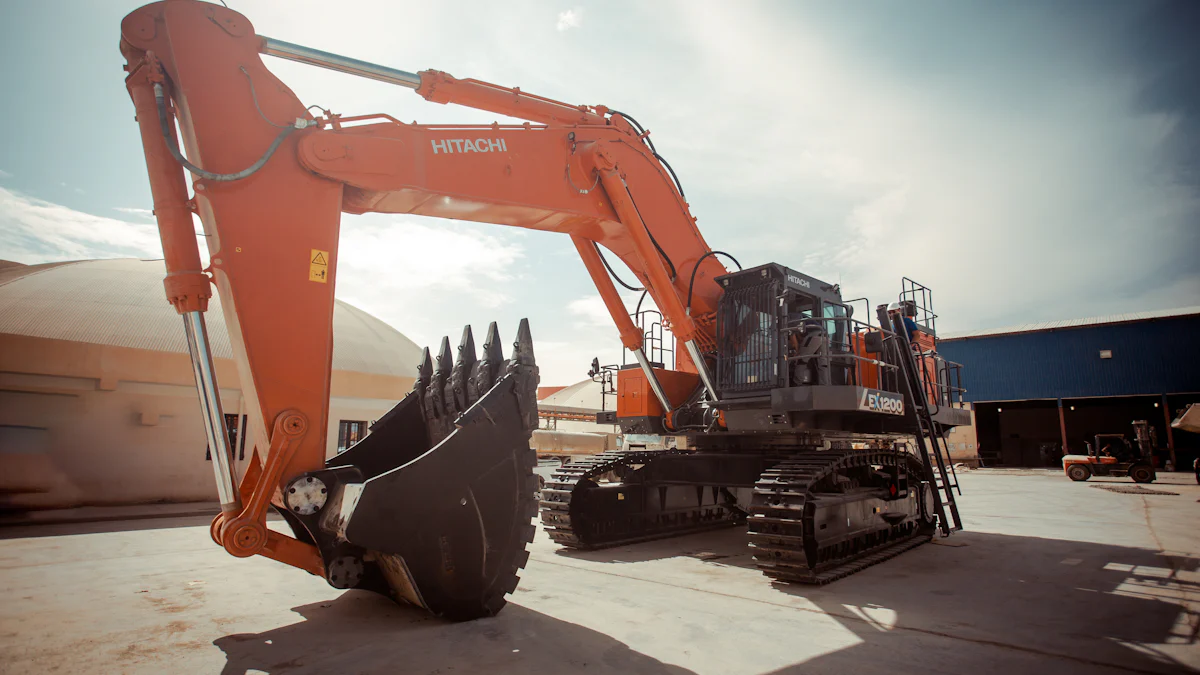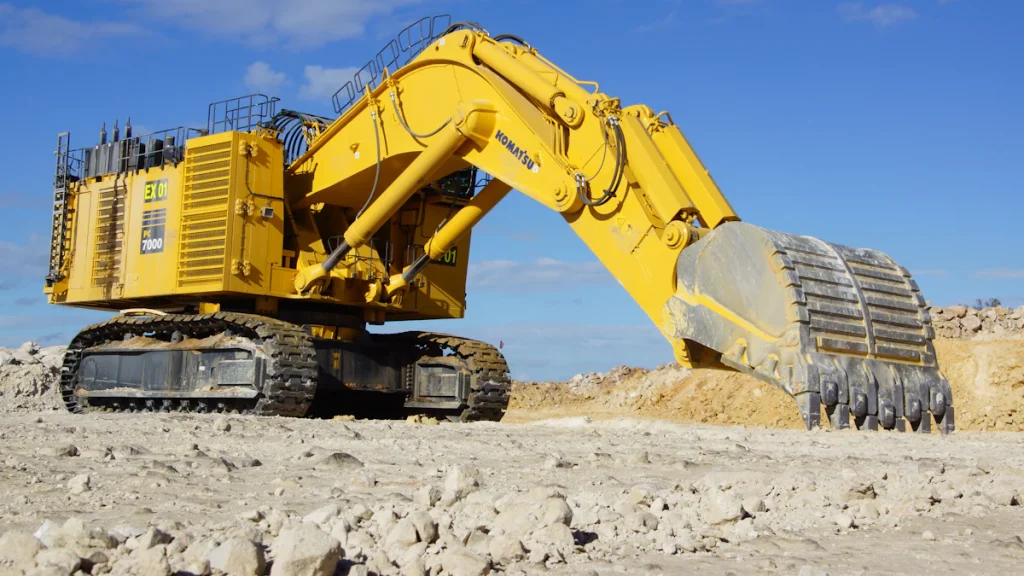
Nagano excavator parts rely on several key components to handle demanding tasks. Each part plays a vital role in ensuring the machine operates smoothly and efficiently. Tracks, hydraulic systems, and the cab are some of the important parts of excavators that require regular attention. For example, track tension must be adjusted properly to avoid maneuverability issues. Contaminants in the final drive motor oil can also cause severe damage. By understanding the main Nagano excavator parts, you can prevent common problems like oil leaks or hydraulic pump failure. This knowledge helps you maintain the performance of your machine.
Maintenance Issue | Description |
|---|---|
Track Tension | Excavator tracks must be properly adjusted; loose tracks can lead to maneuverability issues. |
Contamination | Contaminants in the final drive motor oil can cause serious damage. |
Leakage | Oil leaks can lead to low oil levels, risking excavator failure. |
Hydraulic Pump Failure | Poor maintenance of hydraulic oil can lead to pump failure and engine damage. |
Gearbox Issues | Older excavators may experience gearbox malfunctions requiring replacement. |
Understanding these Nagano excavator parts ensures you can address potential issues before they escalate. Proper care of these key components extends the life of your machine and keeps it running efficiently.
Key Takeaways
Check and fix track tension often to keep it moving well.
Look for leaks in hydraulic systems to avoid big repairs.
Know how cab features like seats and controls help comfort and work.
Keep extra parts ready to fix quickly and avoid delays.
Use good seal kits to stop oil leaks and keep pressure steady.
Undercarriage Components in Nagano Excavator Parts

The undercarriage of an excavator plays a crucial role in its stability and mobility. It consists of several components that work together to ensure smooth operation, even in challenging environments. Understanding these parts helps you maintain your excavator undercarriage and extend its lifespan.
Tracks
Tracks are essential for supporting the excavator’s weight and providing traction. They come in two main types:
Steel Tracks
Steel tracks are highly durable and ideal for rough terrains like quarries or construction sites. They resist damage from sharp objects and extreme conditions. However, they require regular maintenance, such as lubrication and rust prevention, to ensure optimal performance. Steel tracks also allow you to replace individual track shoes, which can save costs over time.
Rubber Tracks
Rubber tracks are better suited for urban environments. Their softer material minimizes damage to sensitive surfaces like asphalt or concrete. They also operate quietly, making them ideal for residential or noise-sensitive areas. Rubber tracks require less maintenance but may wear out faster on abrasive surfaces. When damaged, you must replace the entire track, as internal components cannot be repaired.
Rollers and Idlers
Rollers and idlers guide and support the tracks, ensuring smooth movement and proper alignment.
Bottom Rollers
Bottom rollers distribute the excavator’s weight evenly across the tracks. They also guide the track shoes along the undercarriage. Signs of wear include uneven surfaces, unusual noises, or increased energy consumption. Regular inspections help you identify and replace worn rollers before they affect performance.
Top Rollers
Top rollers prevent the tracks from sagging. They align the chains and facilitate movement between the sprocket and idler. Like bottom rollers, they require periodic checks for cracks, deformation, or excessive heat generation during operation.
Drive Motor
The drive motor powers the excavator’s mobility by converting hydraulic energy into rotational motion.
Travel Motor
The travel motor receives power from the hydraulic pump and transfers it to the final drive. It plays a key role in moving the excavator efficiently across different terrains.
Final Drive
The final drive converts the travel motor’s power into torque, enabling the tracks to turn. This component ensures the excavator can navigate challenging environments with ease. Proper maintenance of the final drive, such as monitoring for oil contamination, prevents costly repairs.
By maintaining these undercarriage components, you can ensure your excavator operates efficiently and remains reliable in demanding conditions.
Cab Features in the Main Parts of an Excavator
The cab of an excavator serves as the operator’s workspace. It combines comfort, functionality, and safety to ensure efficient operation during long hours on the job site. Let’s explore its key features.
Operator Seat
The operator seat is one of the most important components of the cab. It directly impacts your comfort and productivity.
Adjustable Features
Modern excavator seats come with adjustable settings to suit operators of different heights and preferences. You can modify the seat’s height, angle, and lumbar support to find the most ergonomic position. These adjustments reduce strain on your back and neck, allowing you to work comfortably for extended periods.
Comfort and Safety
Advanced seats often include heated and cooled air-suspension systems. These features regulate temperature, keeping you comfortable in extreme weather conditions. Air-suspension seats also absorb shocks and vibrations, minimizing fatigue during bumpy operations. Ergonomic joystick controls are often integrated into the seat design, ensuring easy access and reducing physical strain.
Control Panel
The control panel is the command center of the excavator. Its design enhances efficiency and safety.
Joysticks
Joysticks are strategically placed for intuitive operation. They allow you to control the excavator’s movements and attachments with precision. Their ergonomic design reduces hand fatigue, even during long shifts.
Display Screen
Modern excavators feature Smart Touch displays that provide real-time information about the machine’s performance. These screens often activate rearview cameras, improving visibility and safety. Some models also include assistive software for tasks like on-board weighing, helping you complete jobs more efficiently.
Visibility Features
Visibility is crucial for safe and effective excavator operation. The cab includes several features to enhance your view of the surroundings.
Windows
Large, strategically placed windows provide a clear view of the job site. They reduce blind spots, allowing you to monitor your surroundings effectively. Tinted glass options are available to minimize glare and improve visibility in bright conditions.
Mirrors
Mirrors further enhance visibility by covering areas that windows cannot. Some excavators also offer optional side-view cameras and split-screen displays. These features reduce blind spots and help prevent accidents, ensuring a safer work environment.
By understanding and utilizing these cab features, you can operate your excavator more efficiently and safely. A well-designed cab not only boosts productivity but also ensures your comfort and well-being during demanding tasks.
Arm and Boom Components in Nagano Excavator Parts

The arm and boom system of an excavator is essential for performing tasks like digging, lifting, and material placement. These components work together to provide the reach, flexibility, and power needed for various applications.
Boom
The boom is the backbone of the excavator arm system. It connects the machine’s body to the arm and attachments, enabling precise movements.
Main Boom
The main boom provides the elevation and reach required for excavation or lifting tasks. It extends outward from the excavator’s body, allowing you to position the arm and bucket effectively. This component serves as the foundation for the arm and attachments, ensuring stability during operations.
Articulating Boom
Articulating booms offer greater versatility compared to main booms. They are ideal for confined spaces and can reach over obstacles with ease. These booms often include additional articulation points, enabling you to perform tasks in tight or challenging environments. Their design makes them suitable for both indoor and outdoor applications.
Feature | Articulating Booms | Main Booms |
|---|---|---|
Access in Confined Areas | Excellent for tight spaces. | Limited flexibility in tight spaces. |
Reach Over Obstacles | Superior for reaching up and over obstacles. | Primarily designed for straightforward vertical reach. |
Arm
The arm connects to the boom and plays a critical role in controlling the excavator attachments. It provides the flexibility and precision needed for various tasks.
Arm Cylinder
The arm cylinder powers the movement of the arm, enabling you to extend or retract it as needed. This hydraulic component ensures smooth and controlled operation, even under heavy loads.
Arm Extensions
Arm extensions enhance the reach of the excavator arm, making them indispensable for specific tasks. They allow you to access difficult areas without repositioning the machine frequently. These extensions are especially useful for deep excavation projects, river dredging, and other tasks requiring extended reach. Their hassle-free installation and cost-effectiveness make them a practical choice for many operators.
Attachments
Attachments expand the functionality of your excavator, allowing it to perform a wide range of tasks.
Bucket
The bucket is one of the most commonly used excavator attachments. It is designed for digging, trenching, and material handling. Digging buckets feature teeth for breaking through tough materials, while grading buckets have a flat edge for smoothing surfaces. Both types are essential for construction and landscaping projects.
Grapple
The grapple is ideal for handling irregularly shaped materials like logs, rocks, or debris. Its design allows you to grip and move objects securely, making it a valuable tool for demolition, forestry, and recycling tasks.
By understanding the arm and boom components, you can maximize the efficiency and versatility of your excavator. Proper maintenance of these parts ensures reliable performance and extends the lifespan of your machine.
Hydraulic System and Excavator Couplings
The hydraulic system in an excavator powers its movements and attachments. It ensures smooth operation by converting mechanical energy into hydraulic pressure. Understanding its components helps you maintain efficiency and prevent costly breakdowns.
Hydraulic Pump
The hydraulic pump is the heart of the excavator’s hydraulic system. It converts mechanical energy into hydraulic pressure, enabling the machine to perform tasks like digging and lifting.
Main Pump
The main pump generates high-pressure hydraulic oil to power the excavator’s primary functions. It drives the boom, arm, and bucket movements. Regular maintenance, such as checking for leaks or contamination, ensures the pump operates effectively.
Auxiliary Pump
The auxiliary pump supports additional functions, such as powering attachments like grapples or augers. It provides flexibility, allowing you to use specialized tools for various tasks. Keeping this pump in good condition ensures your excavator remains versatile.
Hydraulic Cylinders
Hydraulic cylinders control the movement of the excavator’s arms and attachments. They play a crucial role in delivering precision and power.
Boom Cylinder
The boom cylinder raises and lowers the boom, providing the elevation needed for digging or lifting. Its robust design ensures it can handle heavy loads without compromising performance.
Bucket Cylinder
The bucket cylinder controls the bucket’s movement, enabling you to scoop, lift, and dump materials. Proper maintenance, such as inspecting seals and fluid levels, prevents leaks and ensures smooth operation.
Tip: When selecting hydraulic cylinders, consider factors like load capacity, stroke length, and operating environment. These factors ensure the cylinders meet your excavator’s specific needs.
Hydraulic Hoses
Hydraulic hoses transport pressurized oil between the pump, cylinders, and other components. They are vital for maintaining the system’s efficiency.
High-Pressure Hoses: These hoses handle pressures between 10 MPa and 100 MPa. They deliver oil to components where high pressure is essential, such as the boom and bucket cylinders.
Low-Pressure Hoses: These hoses, with a maximum pressure of up to 1.6 MPa, are used for oil suction ports. They ensure the hydraulic system receives a steady oil supply.
Note: Regularly inspect hoses for wear or damage. Replacing worn hoses prevents leaks and maintains your excavator’s performance.
By understanding the hydraulic system and its components, you can keep your excavator running efficiently. Proper care of the pump, cylinders, and hoses ensures reliable operation and extends the machine’s lifespan.
Excavator Couplings by YNF Machinery
Excavator couplings play a vital role in ensuring smooth power transmission between the engine and hydraulic pump. YNF Machinery offers high-quality couplings designed to enhance your excavator’s performance and reliability. Let’s explore two popular types: Centaflex-A and Bowex couplings.
Centaflex-A Couplings
Centaflex-A couplings are highly flexible and maintenance-free. These couplings excel in absorbing vibrations and compensating for misalignments, making them ideal for heavy-duty applications. Their robust design ensures durability, even in harsh working conditions.
Key Features:
Flexibility: The couplings handle radial, angular, and axial misalignments effectively.
Durability: High-quality materials withstand extreme temperatures and heavy loads.
Ease of Installation: You can install them quickly without requiring special tools.
Benefits:
Centaflex-A couplings reduce wear and tear on connected components. This feature minimizes downtime and extends the lifespan of your excavator. Their vibration-damping properties also improve operator comfort by reducing noise and vibrations during operation.
Tip: Regularly inspect the coupling for signs of wear. Replacing worn couplings promptly prevents damage to other parts of the hydraulic system.
Bowex Couplings
Bowex couplings are another excellent choice for excavators. These couplings are designed for high-speed applications and provide reliable performance under demanding conditions.
Key Features:
Precision Engineering: Bowex couplings ensure smooth power transmission with minimal backlash.
Compact Design: Their lightweight structure makes them suitable for confined spaces.
High Torque Capacity: They handle significant loads without compromising efficiency.
Benefits:
Bowex couplings enhance the efficiency of your excavator by ensuring consistent power delivery. Their compact design simplifies installation and maintenance, saving you time and effort. These couplings also resist wear, reducing the need for frequent replacements.
Note: Always choose the correct coupling size and type for your excavator model. This ensures optimal performance and compatibility.
YNF Machinery’s couplings provide exceptional value by improving your excavator’s efficiency and reliability. Investing in these high-quality components ensures your machine operates at its best, even in challenging environments.
Engine and Powertrain Components in Parts of an Excavator
The engine and powertrain are the core components that power your excavator and enable it to perform heavy-duty tasks. Understanding these parts helps you maintain their efficiency and avoid costly repairs.
Engine
Diesel Engine
The diesel engine is the heart of your excavator. It generates the power needed to operate the hydraulic system and other components. Diesel engines are known for their durability and ability to handle high loads. Regular maintenance, such as oil changes and air filter replacements, ensures the engine runs smoothly. Monitoring fuel quality also prevents issues like clogging or reduced performance.
Cooling System
The cooling system prevents the engine from overheating during operation. It plays a vital role in maintaining the engine’s efficiency and longevity.
Inspect the cooling system regularly to identify potential issues early.
Maintain the coolant by changing it on time and avoiding mixing different types.
Keep the system clean by removing dirt and debris to ensure proper airflow.
These steps help you avoid overheating, which can lead to severe engine damage.
Powertrain
Transmission
The transmission transfers power from the engine to the tracks, enabling your excavator to move. Proper lubrication and regular inspections keep the transmission functioning efficiently. Neglecting maintenance can lead to reduced performance or even failure.
Gearbox
The gearbox works alongside the transmission to control the excavator’s speed and torque. Over time, the gearbox may experience wear and tear, especially in older machines. Malfunctions in the gearbox often require repairs or replacement. Addressing these issues promptly ensures your excavator remains operational.
Excavator Engine Parts by YNF Machinery
YNF Machinery offers high-quality engine parts designed to enhance your excavator’s performance and reliability.
Pistons and Cylinders
Pistons and cylinders are essential for the engine’s combustion process. They convert fuel into mechanical energy, powering your excavator. YNF Machinery provides durable pistons and cylinders that withstand high temperatures and pressures, ensuring long-lasting performance.
Turbochargers and Fuel Pumps
Turbochargers increase the engine’s efficiency by forcing more air into the combustion chamber. This process boosts power output without increasing fuel consumption. Fuel pumps ensure a steady supply of fuel to the engine, maintaining consistent performance. YNF Machinery’s turbochargers and fuel pumps are engineered for reliability, helping you reduce downtime and operating costs.
By maintaining these engine and powertrain components, you can keep your excavator running efficiently and extend its lifespan.
Hydraulic Cylinder Seal Kits for Nagano Excavator Parts
Importance of Seal Kits
Hydraulic cylinder seal kits play a critical role in maintaining your excavator’s performance. These kits ensure the hydraulic system operates efficiently and reliably.
Preventing Oil Leaks
Seal kits create tight seals within the hydraulic cylinders. This prevents hydraulic fluid from leaking out during operation. By maintaining proper hydraulic pressure, the seals ensure your excavator performs tasks like lifting and digging smoothly. They also block contaminants from entering the system, which helps avoid damage to internal components.
Prevent hydraulic fluid leaks effectively.
Maintain hydraulic pressure for smooth operation.
Block contaminants to protect the hydraulic system.
Ensuring Smooth Operation
Smooth operation of your excavator depends on the integrity of its hydraulic system. Seal kits prevent disruptions caused by fluid loss or contamination. They also help maintain consistent pressure, which is essential for precise movements. With high-quality seal kits, you can rely on your excavator to perform demanding tasks without interruptions.
YNF Machinery Hydraulic Cylinder Seal Kits
YNF Machinery offers premium hydraulic cylinder seal kits designed to meet the needs of various excavator models. These kits combine durability and compatibility to deliver exceptional performance.
Material Durability
The materials used in YNF Machinery’s seal kits ensure long-lasting performance under tough conditions. Each material is selected for its unique properties, making the kits reliable and effective.
Material | Properties |
|---|---|
Rubber | High flexibility and compressibility; resistant to grease, mineral oils, and hydraulic fluids. |
Polytetrafluoroethylene (PTFE) | Remarkable durability under extreme conditions; low friction coefficient; effective when dry. |
Rigid plastics | Offers resistance to temperature, pressure, and chemical reactivity; improved strength with engineered plastics. |
Thermoplastic Elastomers (TPE) | Excellent strength and flexibility; highly resistant to abrasion and tearing; maintains pressure. |
These materials ensure the seal kits withstand high pressure, temperature, and wear, making them ideal for heavy-duty applications.
Compatibility with Various Models
YNF Machinery’s seal kits are compatible with a wide range of excavator models. This compatibility ensures easy installation and optimal performance across different hydraulic systems. Using the right seal kit for your machine offers several benefits:
Improved sealing performance.
Reduced hydraulic fluid leakage.
Increased system efficiency.
Enhanced durability.
Easy installation for minimal downtime.
By choosing YNF Machinery’s hydraulic cylinder seal kits, you can maintain your excavator’s efficiency and extend its lifespan. These kits provide a cost-effective solution for preventing oil leaks and ensuring smooth operation.
Understanding nagano excavator parts ensures you can operate and maintain your machine efficiently. Each component, from the undercarriage to the hydraulic system, plays a vital role in performance. By knowing the parts of an excavator, you can anticipate potential issues and schedule maintenance during non-productive hours. This approach reduces unexpected downtime and repair costs.
Keep an inventory of commonly worn parts to minimize delays during repairs.
Track part conditions with a machine log to identify problems early.
Address multiple components during scheduled maintenance to save time and costs.
YNF Machinery provides high-quality parts of an excavator, including excavator engine parts, couplings, and hydraulic cylinder seal kits. These essential components help you maintain the important parts of excavators, ensuring long-term reliability and efficiency.
FAQ
What are the different types of excavators, and how do they differ?
Excavators come in various types, such as crawler, wheeled, and mini excavators. Crawler excavators excel in rough terrains, wheeled ones suit urban areas, and mini excavators handle compact spaces. Each type serves specific tasks based on size, mobility, and application.
How often should you inspect hydraulic hoses?
Inspect hydraulic hoses every 250 hours of operation or monthly. Look for cracks, leaks, or wear. Regular checks prevent unexpected failures and maintain system efficiency.
What is the purpose of a final drive in an excavator?
The final drive converts power from the travel motor into torque, enabling the tracks to move. It ensures smooth navigation across challenging terrains.
How do you maintain an excavator’s cooling system?
Clean the radiator and remove debris regularly. Check coolant levels weekly and replace coolant as recommended. These steps prevent overheating and extend engine life.
Why are hydraulic cylinder seal kits important?
Seal kits prevent oil leaks and maintain hydraulic pressure. They ensure smooth operation and protect internal components from contamination, reducing downtime and repair costs.





